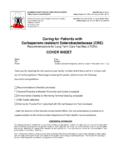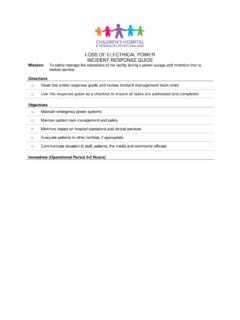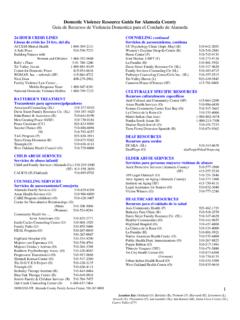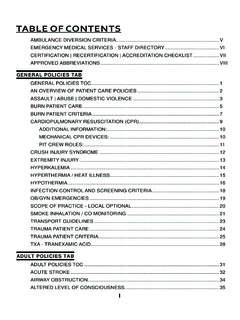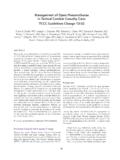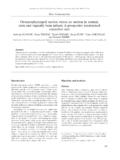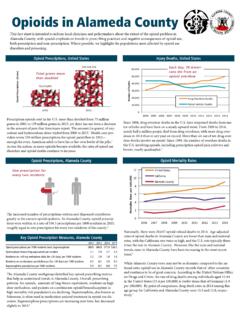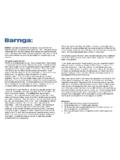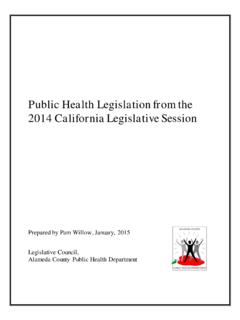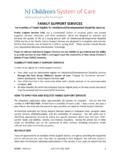Transcription of Preplanning Disaster Triage for Pediatric Hospitals …
1 Preplanning Disaster Triage for Pediatric Hospitals TRAIN TOOLKIT Lucile Packard children s hospital 2 Table of content Introduction 3 TRAIN Matrix 4 Definitions of Categories 5 Instructions Physical 9 Computerized 12 References 14 Appendix A TRAIN Assessment Form Appendix B 1. TRAIN Self-assessment tool: Case Studies 2. Answers to Case Studies Appendix C Education What is TRAIN? (for administration) 3 INTRODUCTION The Triage by Resource Allocation for IN-patient (TRAIN) matrix is a tool for Pediatric hospital Disaster pre-planning . It categorizes Pediatric inpatients according to their resource transportation needs during an evacuation or mass casualty event requiring increased surge capacity.
2 This tool can be implemented manually or within an electronic medical record. It accurately assesses patients quickly and easily to determine transport needs, which allows institutions to request and receive resources required for vertical movement in Disaster . This innovative tool applies to hospitalized patients with regards to their current resource transportation needs. Previous Triage tools are primarily used in the pre- hospital setting and are based on severity of illness or predictors of mortality1-3, which are not applicable to the inpatient population.
3 This tool is most effective when incorporated into daily practices prior to a Disaster . This tool was originally created for the neonatal population4 and then modified for hospitalized Pediatric and obstetrics patients. There are also future plans to incorporate the adult inpatient population. LPCH TRAIN MATRIX Triage by Resource Allocation for IN-patients [TRAIN] Transport Car BLS Critical Care Specialized Life Support Stable Minimal Moderate-Stable Max-Unstable Mobility Car/Carseat Wheelchair/stretcher Transport rig Immobile Nutrition PO Feeds PO/NG NG/PO + TPN/IL NPO & TPN/IL Pharmacy PO Meds PO Meds/IV Meds/IV Fluids IV Drip x1 IV drip > 2 Life Support Minimal = Hood or Low Flow Cannula O2, Peritoneal Dialysis, etc.
4 Moderate-Stable = Conventional Ventilator, CPAP/BiPAP/Hi-Flow, Externally paced, chest tube, wt < 1500 grams, etc. Max-Unstable = Highly specialized equipt., , HFOV, ECMO, iNO, CVVH, Berlin Heart, etc. Mobility Car/Carseat = able to ride in automobile with age-appropriate restraints Transport rig = age-appropriate rig with equipment for connecting to ambulance Immobile = Unsafe to move without special equipment , neurosurgical/bariatric 5 BLUE Transport: Car or Bus Life Support: Stable No need for monitoring* Room air Uncomplicated drains (ie: bili or JP drains) Mobility: Car/Carseat No specialized equipment needed to transport patient Nutrition: PO Feeds Oral feeds only No tube feeds Pharmacy.
5 PO Meds Oral meds only No intravenous medications *These patients may be considered for transport by car/bus or for discharge home in the setting of a Disaster in which altered standards of care are present. 6 GREEN Transport: Ambulance (BLS/ALS) Life Support: Minimal Low flow cannula or hood oxygen Peritoneal dialysis (intermittent) May require cardiorespiratory monitoring Mobility: Wheelchair/stretcher Baseline requirement (cerebral palsy) Restricted mobility due to devices (ie: spica casts, traction, halos, etc) Nutrition: PO/NG Oral feeds in combination with tube feeds (ie: G-tube, nasogastric, nasoduodenal, nasojejunal, orogastric) Pharmacy: PO Meds/IV Meds/IV fluids Intermittent intravenous medications Standard IV fluids (ie: dextrose with electrolytes, etc) 7 YELLOW Transport.
6 Critical Care Ambulance with RN +/- RT +/- MD Life Support: Moderate-stable Conventional Ventilator CPAP/BiPAP/Hi-Flow/Continuous Nebulizer External pacemaker Chest tube Weight < 1500 grams Etc. Mobility: Transport rig As based on equipment required to safely transport patient o Examples: external ventricular drains, etc Nutrition: NG/PO + TPN/IL Combination of enteral feeds (by mouth or tube feed) and parenteral nutrition (total parenteral nutrition/intralipid) Pharmacy: IV drips X1 Can have intermittent intravenous medications Single intravenous medication drip (ie. Insulin, basal narcotic drip, pressors, etc) 8 RED Transport: Specialized Ambulance or Military supported transport with combination of multiple RNs, likely with MD and RT Life Support: Max-Unstable Highly specialized equipment o High Frequency Oscillatory Ventilation o ExtraCorporeal Membrane Oxygenation o Inhaled Nitric Oxide o Continuous Veno-Venous Hemofiltration o Ventricular Assist Devices o Etc.
7 Mobility: Immobile Nutrition: NPO & TPN/IL No enteral feeds Parenteral nutrition only Pharmacy: IV drips 2 Can have intermittent intravenous medications Multiple intravenous medication drips (ie. Insulin, basal narcotic drip, pressors, etc) 9 PHYSICAL ASSESSMENTS USING THE TRAIN MATRIX 10 Daily Process 1. Assign one person daily to complete the TRAIN assessment form (see addendum A). a. This individual may be whoever you decide is capable of completing the process accurately ( , Staff Nurse, Charge RN, Nurse Manager, Physician). b. The accuracy of this tool is best when administered by someone familiar with the patients.
8 2. Enter each of the Unit s bed numbers on the TRAIN assessment form. 3. Enter the name of the patient occupying each associated bed space. 4. Complete the information, including: 1) Date, 2) Time, and 3) Unit 5. Assign the appropriate color to each patient, according to the TRAIN matrix. 6. At the bottom of the table, total the number of patients in each TRAIN category 7. Have the TRAIN matrix and completed assessment forms readily available with Disaster plans on your unit. 11 Instructions on Using the TRAIN Matrix 1. Look at each patient and assess by the following methods a. Attached to Patient i. Airway/Breathing- what equipment is being used, BiPAP, oxygen, etc.
9 Ii. Circulation IV medications running (type and #), feeding tube, ECMO, etc. iii. Physical assessment CT, casts, drains b. In the room i. Machines not in use PD, Bipap ii. Mobility specialized wheelchair in room 2. Each patient will be categorized by maximum needs of each resource type (farthest category to the right). a. For example, a patient who is on room air on a regular diet but is on a basal rate narcotic medication would be categorized as Yellow. 12 COMPUTER ASSESSMENTS USING THE TRAIN MATRIX 13 HELPFUL HINTS FOR COMPUTER CODING We have found that computerization of this matrix decreases impact to nursing workflow and is more accurate and timely than when used manually.
10 There may be institutions which do not yet have this capability, but which may grow to have them. We also recognize that multiple electronic medical record products are available. Each product will require different algorithms and coding elements. The following are helpful hints which we have used to successfully code the TRAIN matrix into our electronic medical record: The most accurate data for Life Support, Mobility and Nutrition resource types were pulled from nursing documentation The most accurate data for Pharmacy was pulled from the electronic medical administration record When programming the algorithm using the TRAIN matrix, categorization occurs with the highest resource need If data is documented in multiple places within the electronic chart, the coding should include both places and use the most recently charted data For Life Support and Nutrition, data is pulled over time (8 hours)
